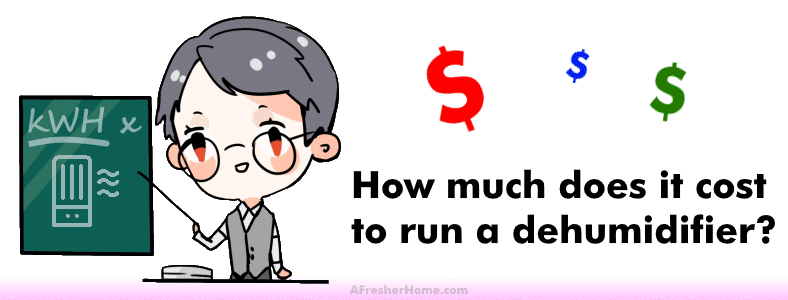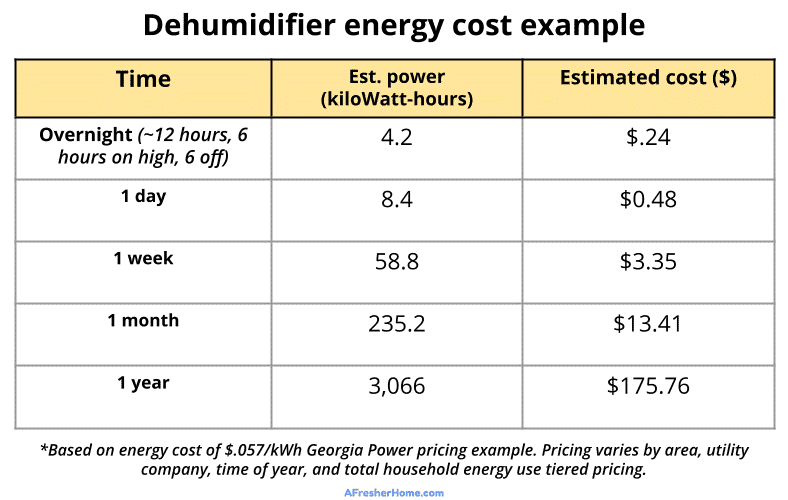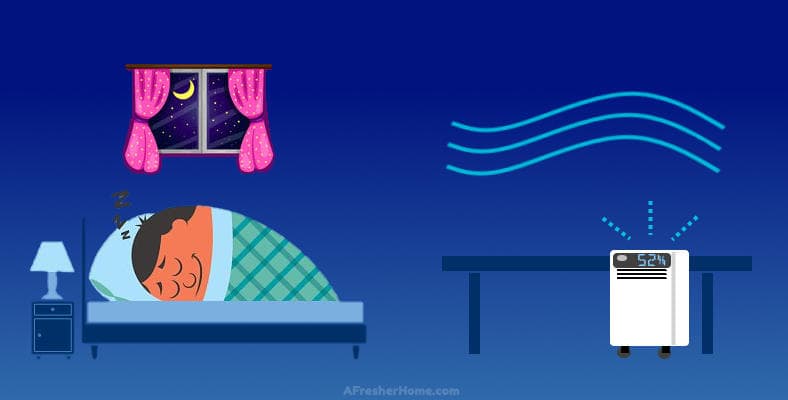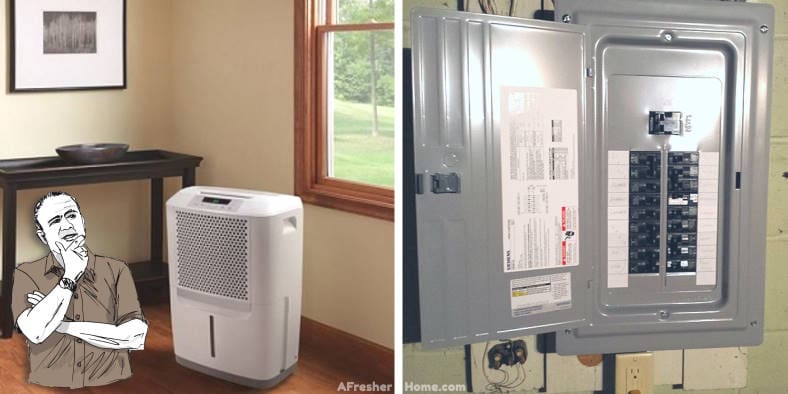Sure, dehumidifiers are extremely helpful in how they can keep dampness under control as well as keep us comfortable. But are they energy hogs? How many amps does a dehumidifier use? And how many watts?
In this article I’ll cover this and more:
- Dehumidifier energy use facts
- How much it costs to run a dehumidifier for a day, week, and more
- Several reasons why they require the amps & watts they need to run
- How they compare to an electric fan or standard air conditioner
Contents
How many amps does a dehumidifier draw?

To keep things simple and easy to follow, I’ve put together a handy table for you. Here you’ll find the most common dehumidifier sizes and amps used for both 120V and 220V for those in other countries.
Basically:
- Use the upper range number for the maximum amps drawn when a dehumidifier is at full speed/full operation.
- Dehumidifiers vary in fan speeds, settings, and modes, so they don’t always draw the maximum amps. It depends on how they’re being used (therefore the amps can be lower depending on this).
| Dehumidifier size/rating | Amps (110V) | Amps (220V) |
|---|---|---|
| 70 pint | 3.1-7.5 | 1.55-3.75 |
| 50 pint | 3.6-7.2 | 1.8-3.6 |
| 30 & 35 pint | 3.2-5.2 | 1.8-2.6 |
| 20 & 22 pint | 2.6, 2.7 | 1.3, 1.35 |
*Note: the larger number of each range is the high end of each type, with the dehumidifier running on high or full capacity.
Do dehumidifiers draw a lot of electricity?

Shown: Graph comparing the energy used by a typical 50 pint dehumidifier vs a small window air conditioner or electric fan, each to the highest setting. Unsurprisingly, the AC uses nearly the same energy since they’re extremely similar in how they work!
Dehumidifiers use a moderate amount of energy: typically several hundred watts which is still much less than many electric heaters, air fryers, ovens, or other appliances. One interesting thing is how similar they are in power use to air conditioners.
A 50 pint/medium-size coverage may use between about 500 to 600W on average, as an example. Larger or smaller units will use more or less accordingly. Here I’ll cover some of the most common sizes.
70 pint dehumidifiers are very common and one of larger units you’ll find for sale. They use around 600W to 700W and as much as around 800W in some cases. The amps drawn are up to around 7.5 amps for 110V models on the high setting.
50 pint dehumidifiers use close to 600W and nearly as much as some 70 pint models in some cases (up to around 700W or more). The amps drawn are about 3.2 to 7.2A depending on the setting and model.
Why do some dehumidifiers use more or less power?
The amount of power used varies by the design of the dehumidifier and how powerful they are.
Larger units can remove moisture from larger spaces so they require a bigger compressor and refrigeration system just as you might expect. Therefore larger models need more power to drive the motor that turns the compressor.
Air conditioning (AC) units also use a fan and refrigerant system circulated by a compressor as well which is why they’re very similar in how much electricity they require.
How much does it cost to run a dehumidifier?

We can use what we know about the amps or watts a dehumidifier draws (from above, for example) to estimate how much it costs to run one per day, week, month, and a whole year.
Estimating dehumidifier energy use costs
Electric companies normally bill you based on the number of kilowatt-hours you use. Kilowatt-hours are a number based on the amount of power drawn and how much time it’s used for.
That number is then used to multiply times the local energy price by your utility company to create your power bill.
For example, let’s say we have a 50 pint dehumidifier that draws 700W of power, and when set to auto mode it runs on high for 12 hours per day. You’ll have 700W x 12 hours = 0.7kW x 12 hours = 8.4 kWh (kilowatt-hours).
Knowing that we can make a handy chart to estimate the cost based on the local electrical pricing. Let’s use an example from my home state of Georgia ($.057 per kWh). At 12 hours per day, our example dehumidifier would cost:
Dehumidifier power cost chart

As you can see here, it’s actually fairly cheap to run a dehumidifier quite a bit! Of course, the cost will depend on where you live as some electric power rates are nearly twice as much (or more!) than what I’ve listed here for Georgia.
To be sure you don’t waste energy, you’ll want to shop for a dehumidifier with the following features:
- Auto-sensing on/off (“auto”) mode: the compressor will turn on and off as needed when the humidity rises above or at/below a set limit. This means it won’t run all day and night, consuming significantly more power.
- Good humidity level adjustment controls: not all dehumidifiers are designed equally. For example, some let you adjust the humidity comfort (on/off threshold) within only increments of say 5. While others give you much finer control (in units of 1, like 51%, 49%) which means you don’t have to worry about the level be set higher or lower than you’d like.
- Energy-efficient models: some models have somewhat better efficiency than others. When shopping, the energy ratings (normally available for appliances inside the United States) make it easy to compare how much you’ll pay to run them.
Is it OK to leave a dehumidifier on all night?

Yes, it’s ok to leave a dehumidifier running all night as long as it’s above very cool temperatures. A dehumidifier with an auto mode feature will turn off automatically once the humidity level you’ve set has been reached.
Ultimately, as I mentioned earlier, there’s no real reason can’t run yours all night long – there’s no harm in it, and it won’t cost very much money as long as it’s a model that shuts off the compressor or “high” mode once the humidity is under control. Those that don’t will cost at least twice as much to run, but that’s still not much money in most cases.
Dehumidifiers can run for extended periods of time:
- As long as they don’t build up ice or are used at too low a temperature (dehumidifiers, much like air conditioners, don’t work well in low temps if at all).
- If it’s working properly: dehumidifiers with a coolant leak/low refrigerant or other problems won’t be able to pull moisture from the air enough to make much of a difference. That means they’ll run and run and run without helping much and will drive up your energy bill because the compressor may never shut off!
Should a dehumidifier be on its own circuit?

The great news is that standard household dehumidifiers do not need their own circuit – they can share a circuit powering other appliances as long as the total power draw isn’t too high. However, you do need to be aware of the total power drawn by everything plugged in to avoid tripping the breaker and shutting everything off.
For example, let’s say you have a 35 pint dehumidifier that draws about 500W when it’s running on high/fully working. Home circuit breakers/home wiring circuits are rated for about 80% of their maximum trip current, so for a 15A circuit that’s about 1,440W we can expect to have available at 120V.
Therefore, 1,440W – 500W = ~940W we have left to share with other appliances. That won’t work for using a toaster oven, air fryer, or electric heater on the same circuit. You’d need to plug those into their own circuit since they often use 1,000W+ of power).
Some things like high-power microwave ovens, for example, are right on the edge and may or may not trip the breaker when used at the same time – sometimes it doesn’t happen right away!
However, that means you’d have enough power available for most standard home electrical outlets to power your dehumidifier, electric fan, and electronics like TVs or a home stereo.


Nice information resource for parents. At the very top of the long page where you compare current draw across several differing unit sizes, some typos: the 70 pint table line item shows a 3.25a draw @ 220v, and 7.5a @ 110v. The correct numbers s/b either closer to 3.75a @ 220v, OR 6.5a @ 110v(but NOT both changes).
Regarding the last line item comparing current draw ranges for 20 & 22 pint size dehumidifiers, its just good writing habit to keep all line items showing a range of values, either positioning from high to low, or low to high, but not reversing the order indiscriminately for one line item willy-nilly. It leads to reader confusion.
Finally, it appears that the chart showing unit type by power use, I believe you transposed the bar-chart for Small Room A/C (red), with 50 Pint Dehumidifier(blue). I see what you were trying to show there, but I’m not sure that most readers do.
Georgia, and Engineering, I can only remember being accepted into GEORGIA TECH in 1982. I, instead went to Rensselaer in NYS, but Georgia Tech was my third choice after Clarkson College.
Nice campus, and drastic change from NYS education. I wonder now, how that change would have effected my career path.
Nice work here. Keep on keeping-on!
Thanks for catching those typos Lowell as well as the image; I’ve corrected them. No idea how those things slipped through.
I appreciate someone like yourself letting me know so I can fix it. Have a good day & thanks for your time. :)